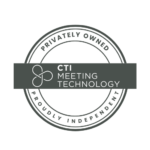As a meeting organizer, we know that you are always on the lookout for different ways to keep your attendees engaged and provide an amazing event experience. There are many trends shaping events this year, but recently, the concept of gamification has emerged as a powerful asset for enhancing the overall experience of virtual meetings. But what exactly is gamification?
Well, according to Oxford Dictionary, it refers to “the use of elements of game-playing in another activity, usually in order to make that activity more interesting”. In the context of virtual events, gamification refers to the integration of game-like elements – such as challenges, or quizzes for example – that relate to the event topic and enhance attendee participation and engagement.
In this article, we will explore multiple ways you can use gamification to craft a better event experience, and even give you some examples of activities you can use at your next meeting!
The power of gamification in virtual events:
To truly understand the potential that this tool offers for virtual events, let’s talk numbers. According to a study by Foerde and Shohamy, gamification leads to a strong hippocampal activation which makes the content easier to recall. In fact, learners often remember only 10% of what they read, and 20% from what they hear. But they can recall up to 90% of an interactive gamified task. These activities have an extremely high engagement rate, reporting that only about 3% of participants will remain unproductive during the activity.
Not too bad, right? Now you just need to find the right gamification activity for your attendees, and include it while seamlessly aligning to the event topic. As daunting as this new world might seem, it’s actually easier to implement than you think. You might have already implemented gamification tools in your meetings without realizing!
Examples of gamification:
Perhaps one of the clearest examples of gamification – and one of the easiest to implement – is a virtual badge system, similar to those obtained in video games when completing a goal or milestone. You can reward participants for completing specific tasks during the event, which provides a sense of accomplishment beyond the learning experience of the meeting itself.
Or what about something more traditional and familiar, such as a virtual scavenger hunt? You can weave a series of clues or challenges throughout the event platform, adding a little extra fun for your participants. This can serve as the perfect opportunity to network by working with other attendees with similar interests.
As you can see, gamification and virtual events are a perfect match, encouraging active participation from your attendees.
Engagement and active participation are essential to virtual meetings. Easier said than done, of course. Attendees often drift away and struggle to keep their focus consistent during online conferences. By introducing rewards and other types of game elements, participants are incentivized to actively engage with the content being presented and discussed. Gamification tools also create a sense of excitement and anticipation, similar to playing a video game, and turn attendees into enthusiastic and engaged participants.
In short, gamification makes active participation fun for participants by encouraging them to join, participate, and be an active part of the virtual event. This will provide a memorable meeting experience for your attendees.
Check out how a gamification activity like polling can enhance the scientific meeting experience.
Gamification not only helps create immersive experiences that captivate attendees, it also generates a sense of community, encouraging attendees to interact, collaborate, or even compete with other participants! This aspect of gamified activities contributes positively to networking opportunities and fosters connections that extend beyond the virtual event.
Gamification can also enhance the attendee’s networking experience. Networking is usually linked to in-person meetings, as virtual events lack face-to-face interactions. Thankfully, gamification has the potential to transform this situation and help participants break the ice and interact with each other. This aspect increases the overall value of attending the virtual meeting by enhancing the networking outcomes for participants.
Utilizing games and challenges as ice-breakers is the best way to implement gamification into the networking aspect of the virtual event. This approach turns networking into an enjoyable activity rather than a chore, and positively affects the whole virtual event experience, even surpassing the networking aspect of traditional meetings.
How to incorporate gamification into the planning process:
Integrating gamification elements into the planning process of your virtual event requires thoughtful consideration and analysis. To simplify this process, here are a few steps to help organizers use gamification to its maximum potential:
- Identify your Objectives: The first thing you need to do is clarify why you’re using gamification and the specific objectives it will help you achieve. Setting goals will help you brainstorm the perfect gamification activities and how to better include them during your virtual event. Goals you might want to achieve include increasing active participation or fostering networking.
- Choose Game Elements: Once you set up your objectives, it’s going to be easier to identify and select the game elements that better align with them and resonate with your target audience. It’s very important that you take attendee behavior into consideration to choose the activity that will lead to the best outcome. Also, don’t forget to tailor these game elements according to your event! Depending on the content and topics covered, you might want to select badges, set up a leaderboard competition, or quiz your attendees.
- Design Engaging Challenges: The main purpose of gamification is to keep your attendees engaged. Make sure the activities and challenges chosen are interesting to your participants to keep them entertained during the virtual meeting. These activities need to be interactive and incorporate relevant event content.
- Implement a User-Friendly Interface: Virtual event attendees come from different places and backgrounds, so organizers need to make sure that the gamification elements incorporated are easily understood and accessible by all participants. Ensure that the gamification features are integrated seamlessly into the event platform to provide a satisfying experience for attendees. Finding a provider that can integrate gamification without a hassle into the virtual event platform should be a priority during your meeting planning.
- Analysis and Improvement: Lastly, you have to monitor and check if gamification helped you reach your objectives. Gather all relevant information and feedback from participants. This will allow you to decide whether this was a success or not, and make any necessary adjustments to improve future event experiences.
Measuring gamification success:
As we mentioned before, measuring the success of gamification is crucial to understanding its impact on the event and improving for the future. But how can you do that? Take a look at the following metrics to assess the effectiveness of your gamification strategy:
- Participant Engagement: The main reason to implement gamification is to enhance participant engagement. You can measure the level of engagement by analyzing their interaction with gamified elements, such as number of badges, answers to quizzes, polls, etc. Some software providers might even provide these statistics on the virtual platform so organizers don’t have to check manually.
- Time Spent: Participants should stay until the end and complete their given tasks to really consider it successful. Assess the amount of time participants spend actively engaged with gamified activities compared to non-gamified ones. This will give organizers an insight into the effectiveness of gamification in capturing attendee attention and keeping interest throughout the virtual meeting.
- Networking Success: We have explored the possibilities that gamification offers for networking. Organizers need to evaluate the outcomes of incorporating game-like networking activities by tracking the number of connections made, business leads, and similar metrics.
- Post-Event Surveys: Participant feedback is a gold mine of information. Don’t miss the opportunity to gather feedback through surveys to measure their overall satisfaction and enjoyment. Dedicate a couple of questions specific to the gamification elements implemented to improve future virtual events.
As you can see, there are multiple metrics and ways of measuring gamification’s success, but you should assess those that resonate with your event objectives to create more engaging and impactful experiences.
Don’t know what to ask in your post-event survey? Check out our list of questions you need to ask to obtain relevant feedback.
—
In conclusion, as the virtual landscape continues to evolve in the event industry, gamification opens up exciting possibilities for creating more engaging and enjoyable experiences for participants. As an event organizer, it’s important to adapt gamification elements into your virtual meetings to encourage active participation and attendee satisfaction. At the end of the day, a happy attendee will probably remember your event longer and even participate in future meetings!
Are you ready to unleash the full potential of your virtual events? Explore our complete meeting software solution for virtual events, including gamification elements such as polling.






